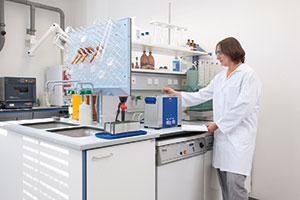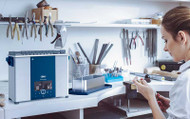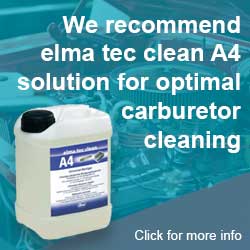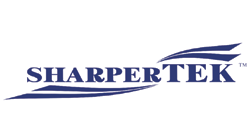Ultrasonic Bath Safety Precautions
|
Let Us Help We can help you
find the perfect storage unit for your needs and budget. |
Operating an ultrasonic cleaner is a broad subject covering more than just turning the unit on and proceeding with a cleaning cycle. Important safety practices apply to any size ultrasonic cleaner including the ultrasonic bath where cleaning takes place. Safety begins upon receipt of your ultrasonic cleaner by, of all things , reading the operators manual to become totally familiar with all phases of the cleaning equipment and its operation.
By doing so you are on the way to ensuring a smooth-running experience with one of the most effective ways to remove contaminants from virtually any product that can be safely immersed in a water-based biodegradable ultrasonic bath solution or, with specially designed cleaners, volatile cleaning solvents.
This post looks at applying good safety practices dealing with:
- The operator
- The ultrasonic cleaner
- Cleaning solution formulas
- Special safety features
- Equipment maintenance
Good Personal Safety Practices during Ultrasonic Cleaning
Recommended ultrasonic bath cleaning solution temperatures are provided by the manufacturer, and a high temperature is not always desirable.
Nevertheless, you should never reach into an operating ultrasonic cleaner bath to remove and inspect parts. Not only do you risk burns, but cavitation can also penetrate your skin. Not a good thing.
The solution? Wear protective gloves before removing baskets containing the parts for inspection - the parts will be hot too!
Hearing protection may also apply to good personal safety practices. Although ultrasonic frequencies are defined as sound above the range of human hearing, audible sound is generated by the vibration of cleaning tank walls and other sources.
The potential for undesirable noise increases at lower cleaning frequencies such as 25 and 45 kHz. Over time this can be annoying to personnel.
The solution? Ear protection devices, cleaning tank covers or placing the ultrasonic cleaner in a sound-suppressing case.
Safe Operating Practices for Ultrasonic Baths
 You've made an investment in ultrasonic cleaning equipment. There are a number of steps you can take to safely operate this equipment and contribute to a long, satisfactory service life.
You've made an investment in ultrasonic cleaning equipment. There are a number of steps you can take to safely operate this equipment and contribute to a long, satisfactory service life.
Provide Reliable Power
Ultrasonic cleaners use powerful transducers to convert electrical energy to sound. Cleaners are supplied with a three-prong grounded outlet for their power source and must be connected to a similarly grounded outlet.
We also strongly suggest that the ultrasonic cleaner have its dedicated outlet, not an outlet or circuit providing power to other equipment such as a sterilizer, autoclave, or air compressor. Circuit overloads could cause an outage, an unwelcome occurrence in any situation.
Safe Practices for Equipment
Other precautions can keep the equipment operating at peak efficiency.
One of those measures is that items should not be placed directly on the bottom of the tank, ultrasonic vibrations that create the cavitation bubbles will also vibrate items in contact with the tank, eventually causing wear that can penetrate the tank bottom. This voids the manufacturer's warranty.
Instead, items should be placed in a mesh-bottom basket or tray suspended above the tank bottom. Note that some large industrial ultrasonic cleaners may be fabricated with ridges on the tank bottom to hold heavy parts. Alternatively, parts to be cleaned can be suspended from overhead racks to keep them from contacting the tank bottom.
For more on this check and other important points, check our ultrasonic learning center videos
Maintaining proper ultrasonic bath levels in the tank is also critical to safety practices. These units are designed for a specific volume (level) of cleaning solution. In many units this is indicated by a fill line.
Evaporation and drag-out lowers the level. Manufacturers recommend that operators do not allow units to operate when the tank is less than 2/3 full. That's because a low liquid level can damage the generator and heaters within the equipment.
See our maintenance section below for additional suggestions.
Good Practices for Selecting Ultrasonic Bath Chemistry
Ultrasonic cleaners work at their best with a water-based, biodegradable detergent solution. Over the years a wide variety of ultrasonic bath formulations have come on the market. Most are shipped as concentrates; others are formulated to operate at full strength.
They are tailored to specific cleaning jobs ranging from cleaning grossly contaminated engine parts to medical and surgical instruments.
iUltrasonic offers a large selection of cleaning solution formulations.
We also provide advice on where the cleaning solutions are best employed.
Volatile Cleaning Solvents
Certain cleaning requirements may call for a volatile cleaning solvent such as IPA and acetone. In these instances, special precautions apply to avoid a fire, explosion, and health-related problems for personnel.
For these applications use explosion-resistant or explosion-proof equipment, together with code-required compliance concerning installation and operation.
Find more information on cleaning with flammable solvents.
Special Ultrasonic Cleaner Safety Precaution Features
Purchasing an ultrasonic cleaner equipped with a timer is strongly recommended. Some units show set and elapsed time and will shut down at the end of the cycle. Others can operate continuously with an auto shutdown at 12 hours.
Models without an auto shut-down risk damage if users do not manually turn them off before leaving for the day or weekend. If this happens equipment is likely to burn out and/or damage parts left in the tank due to evaporation of the cleaning solution.
Find ultrasonic cleaners that incorporate this safety shut-off feature. We have a full line of cleaners with different capabilities. Browse our ultrasonic cleaners
How Maintenance Contributes to Ultrasonic Cleaner Safety
Your instruction manual will have a section on tank maintenance.
The vibration created by ultrasonic transducers creates wear spots on the bottom of the tank that over time develop into abrasions termed cavitation erosion. This occurs even in tanks fabricated of cavitation-resistant stainless steel. This erosion will necessitate tank replacement before leaks develop to avoid damaging or destruction of equipment electronics.
You can prolong cleaning tank life by following these simple suggestions:
- When changing ultrasonic baths flush out residues, especially metal particles and rust films that fall to the bottom of the tank during cleaning operations. These can serve as "drills" when vibrated by the transducer.
- Use the correct ultrasonic bath formulation. For example, do not use aqueous cleaning media with pH values in the acid range (pH < 7) directly in the ultrasonic tank. (Ask us about acid-resistant plastic inserts available as liners.)
- Drain cleaning solutions before they become too contaminated (and reduce cleaning efficiency). Clean the tank and fill it with a fresh solution.
- Turn your ultrasonic cleaner off when not in use.
We hope this information is useful in helping you to operate your ultrasonic cleaner in a safe manner.
For more information on finding an ultrasonic cleaner that meets your needs, and for operating and maintenance recommendations contact the ultrasonic cleaning experts for unbiased recommendations.







